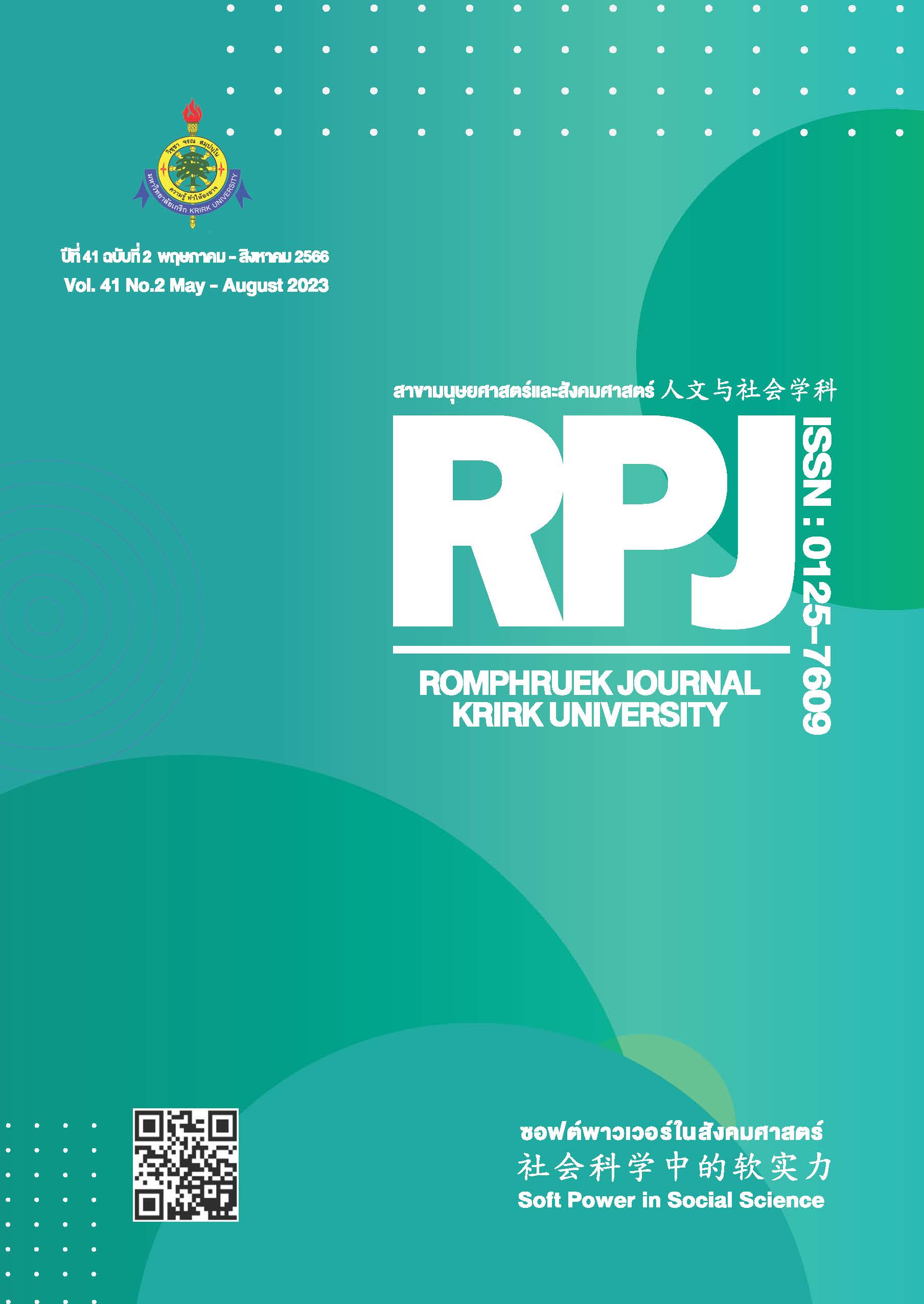การพัฒนาผลิตภัณฑ์ตานีสยามด้วยแนวคิดเศรษฐกิจหมุนเวียนจากฐานภูมิปัญญา เพื่อการพัฒนาที่ยั่งยืน ภายใต้สถานการณ์โควิด-19 ของกลุ่มวิสาหกิจชุมชนบ้านช่างสกุลบายศรี ตำบลเจ็ดเสมียน อำเภอโพธาราม จังหวัดราชบุรี
Main Article Content
บทคัดย่อ
การวิจัยครั้งนี้มีวัตถุประสงค์เพื่อ 1) ศึกษาข้อมูลพื้นฐาน จุดแข็ง จุดอ่อน โอกาส และอุปสรรคการดำเนินงานของกลุ่มวิสาหกิจชุมชนบ้านช่างสกุลบายศรี 2) ศึกษาแนวทางการพัฒนาผลิตภัณฑ์ตานีสยามด้วยแนวคิดเศรษฐกิจหมุนเวียนจากฐานภูมิปัญญาเพื่อการพัฒนาที่ยั่งยืน เป็นการวิจัยเชิงคุณภาพ สัมภาษณ์เชิงลึกจากผู้ให้ข้อมูลหลัก จำนวน 30 คน ด้วยแบบสัมภาษณ์กึ่งโครงสร้างที่ผ่านการพิจารณาความเที่ยงตรงของเนื้อหาจากผู้เชี่ยวชาญ 3 คน วิเคราะห์ข้อมูลโดยการวิเคราะห์เนื้อหาและการตรวจสอบสามเส้าแบบองค์รวม ผลการวิจัยพบว่า การดำเนินงานของกลุ่มวิสาหกิจชุมชนบ้านช่างสกุลบายศรีได้รับผลกระทบจากการแพร่ระบาดของไวรัสโคโรน่า (COVID-19) เป็นอย่างมากส่งผลต่อจุดแข็ง จุดอ่อน โอกาส และอุปสรรคการดำเนินงานของกลุ่มที่ต้องปรับเปลี่ยนเพื่อความอยู่รอดของการดำเนินงาน ด้วยกระบวนการพัฒนาผลิตภัณฑ์ที่ประยุกต์ใช้ภูมิปัญญาดั้งเดิมพัฒนาต่อยอดสู่ภูมิปัญญาใหม่ ประกอบด้วย 1) การบริหารจัดการ 2) การพัฒนาผลิตภัณฑ์ 3) การถ่ายทอดภูมิปัญญา 4) การสร้างระบบเศรษฐกิจหมุนเวียน และเพิ่มเสน่ห์ด้วยการนำเสนอเรื่องเล่าที่บอกกล่าวถึงที่มาของการพัฒนาผลิตภัณฑ์จากความเชื่อสู่แฟชั่น เรื่องกล้วย ๆ ช่วยชุมชน หรือ นวัตกรรมราชินีกล้วย อย่างมีความหมายทำให้ได้ผลิตภัณฑ์ใหม่ที่ใส่ในกับสิ่งแวดล้อมและช่วยยกระดับเศรษฐกิจฐานรากของเกษตรกรที่แตกต่างไปจากแนวคิดเกษตรแบบดั้งเดิม
Article Details

อนุญาตภายใต้เงื่อนไข Creative Commons Attribution-NonCommercial-NoDerivatives 4.0 International License.
ทุกบทความที่ตีพิมพ์ในวารสารมนุษยศาสตร์และสังคมศาสตร์ร่มพฤกษ์เป็นทัศนะและข้อคิดเห็นของผู้เขียนมิใช่ทัศนะของมหาวิทยาลัยเกริกหรือกองบรรณาธิการ การนำบทความส่วนใดส่วนหนึ่งหรือทั้งหมดไปพิมพ์เผยแพร่ต้องอ้างอิงที่มาให้ชัดเจน
เอกสารอ้างอิง
กรมส่งเสริมการเกษตร. (2562). พระราชบัญญัติส่งเสริมวิสาหกิจชุมชน ฉบับที่ 2. (2 พฤษภาคม 2565). สืบค้นจาก https://www.doae.go.th/upload/files/smce.PDF.
กฤษฎา ศรีธรรมา. (2554). ภูมิปัญญาท้องถิ่นอีสาน. โครงการจัดทำตำราและงานวิจัยเฉลิมพระเกียรติ 84 พรรษา พระบาทสมเด็จพระเจ้าอยู่หัว มหาวิทยาลัยกลุ่มภาคตะวันออกเฉียงเหนือ. มหาวิทยาลัยราชภัฎมหาสารคาม, มหาสารคาม.
โกศล ดีศีลธรรม. (2556). ผลิตภัณฑ์รักษ์โลกตามธุรกิจเส้นทางสีเขียว. Technology Promotion, 40(3), 49-52.
คณะกรรมาธิการการพาณิชย์และการอุตสาหกรรมวุฒิสภา. (2563). คณะกรรมาธิการการพาณิชย์และการอุตสาหกรรมวุฒิสภาศึกษาดูงานที่เชียงใหม่เฟรชมิลค์ฟาร์ม.(2 พฤษภาคม 2565). สืบค้นจาก https://www.senate.go.th/view/1/รายละเอียดข่าว ภาพข่าวคณะกรรมาธิการ/ภาพข่าว คณะกรรมาธิการ/5196/TH-TH#MainContent.
จีรนันท์ นาคสมทรง. (2563). เศรษฐกิจหมุนเวียนหนทางสู่การพัฒนาที่ยั่งยืนและบทบาทของการบัญชี.วารสารการบัญชีและการจัดการ มหาวิทยาลัยมหาสารคาม, 12(3), 157-172.
เทิดชาย ช่วยบำรุง. (2554). ภูมิปัญญาเพื่อการพัฒนาท้องถิ่นเชิงสร้างสรรค์. กรุงเทพฯ : สถาบัน พระปกเกล้า.
ธนกร สดใส.(2565). ประธานกลุ่มวิสาหกิจชุมชนบ้านช่างสกุลบายศรี. สัมภาษณ์, 2 เมษายน พ.ศ.2565.
ภัทราพร แย้มละออ. (2561).เศรษฐกิจหมุนเวียน โอกาสใหม่ของธุรกิจเพื่อความยั่งยืน. (2 พฤษภาคม 2565). สืบค้นจาก http://www.allaroundplastics.com/article/sustainability/1898.
ระพีพรรณ จันทรสา. (2560). การจัดการภูมิปัญญาท้องถิ่น. มหาวิทยาลัยราชภัฏอุดรธานี, อุดรธานี.
รัชฎาพร เกตานนท์ แนวแห่งธรรม. (2560). แนวทางการพัฒนาผลิตภัณฑ์ภูมิปัญญาท้องถิ่นเพื่อส่งเสริมเศรษฐกิจสร้างสรรค์ ในจังหวัดนครปฐม. สาขามนุษยศาสตร์ สังคมศาสตร์และศิลปะ, 10(1), 994-1013.
สถาบันสิ่งแวดล้อมไทย.(2556). ข้อกําหนดฉลากเขียวบริการทําความสะอาด(Cleaning service). โครงการฉลากเขียว. กรุงเทพฯ : สํานักงานมาตรฐานผลิตภัณฑ์อุตสาหกรรม.
สหประชาชาติ.(2558). เป้าหมายการพัฒนาแห่งสหัสวรรษSustainable Development Goals (SDGs) ฉบับเต็ม. (2 พฤษภาคม 2565). สืบค้นจาก http://e-plan.dla.go.th/activityImage/422.pdf.


